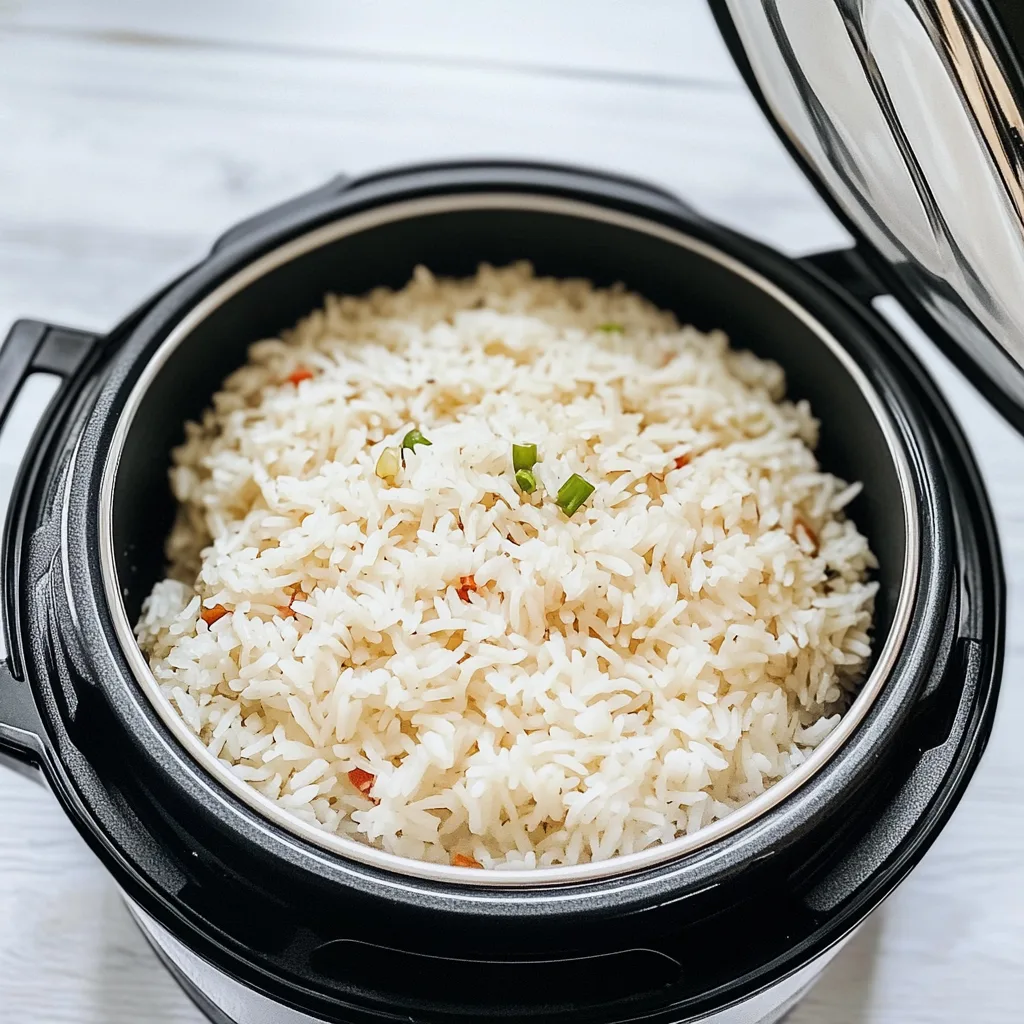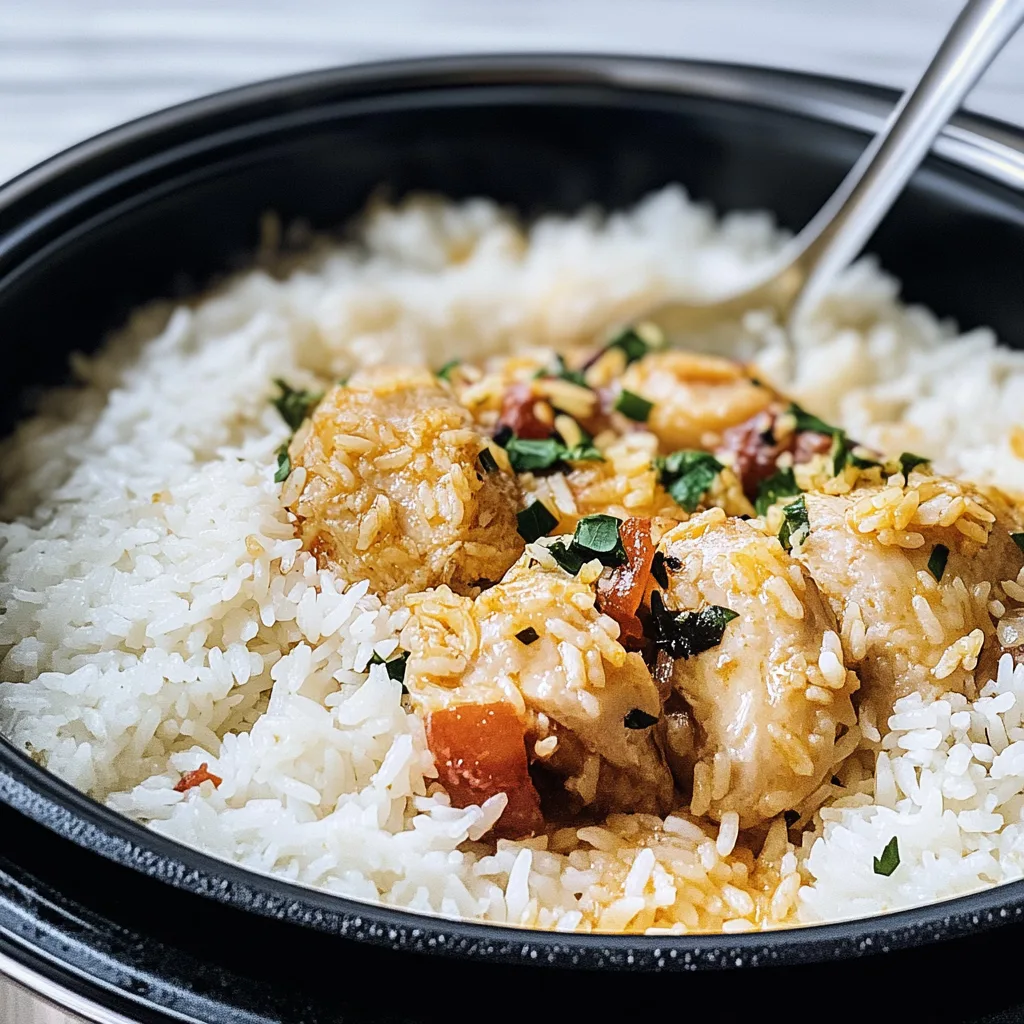Cook basmati rice in Rice Cooker : to perfection is a skill that elevates any dish, from simple rice bowls to elaborate curries and pulaos. Its light, fluffy texture and aromatic flavor make it a favorite choice for meals around the world . While traditional stovetop methods can be time-consuming and require constant attention, a rice cooker simplifies the process, ensuring consistent and effortless results.
In this guide, we will explore how to cook basmati rice in a rice cooker with step-by-step instructions, expert tips, and flavor-enhancing variations. Whether you’re a seasoned cook or a beginner, mastering this technique will transform your culinary creations. For inspiration, consider pairing your rice with flavorful dishes like Boston baked beans or hearty mains such as slow-cooked ribs.
Why Is Basmati Rice So Popular?
Basmati rice has earned its reputation as a staple in cuisines across the globe, particularly in Indian, Pakistani, and Middle Eastern dishes. Its unique qualities include:
- Aromatic flavor: Often described as nutty and floral, its distinct fragrance enhances the dining experience.
- Long, slender grains: These grains remain separate and fluffy when cooked, creating an elegant presentation.
- Nutritional benefits: Rich in complex carbohydrates and fiber, basmati rice provides a healthy and satisfying base for meals.
Unlike other rice varieties, basmati requires specific cooking techniques to unlock its full potential. A rice cooker is an excellent tool for achieving consistent results with minimal effort.
Why Use a Rice Cooker to cook Basmati Rice?
A rice cooker is the perfect appliance for cooking basmati rice, offering:
- Ease of use: No need to monitor the stove or adjust heat levels.
- Precision: Delivers consistent results every time by controlling temperature and timing.
- Versatility: Allows for the addition of spices, herbs, or vegetables for a customized dish.
By using a rice cooker, you can enjoy restaurant-quality rice at home without the hassle. It’s especially useful for preparing large quantities of rice for gatherings or meal prep. For additional recipe ideas, check out how to pair perfectly cooked rice with creative side dishes.
With these benefits in mind, let’s dive into the step-by-step process of cooking basmati rice in a rice cooker.

Why Use a Rice Cooker to Cook Basmati Rice ?
1. Convenience and Consistency
Using a rice cooker eliminates the guesswork associated with cooking basmati rice. It provides:
- Even cooking: Perfectly fluffy rice without sticking or burning.
- Effortless preparation: Just measure, set, and let the cooker do the work.
- Customizable results: Add spices, herbs, or vegetables for variety.
2. Nutritional and Culinary Benefits
Basmati rice is celebrated for its unique aroma and health benefits:
- Low glycemic index: Helps maintain steady blood sugar levels.
- Rich in fiber: Aids digestion and promotes gut health.
- Aromatic flavor: Pairs well with both savory and sweet dishes.
If you’re looking for a versatile base for dishes like hearty chili or savory sides, consider exploring recipes such as how to make deer chili for creative pairings.
Ingredients to Cook Basmati Rice
Essential Ingredients
- 1 cup basmati rice (aged, long-grain preferred)
- 2 cups water (adjust based on rice type)
- 1 tablespoon oil or butter (optional for moisture and flavor)
- ½ teaspoon salt
Optional Additions
- Saffron strands: For a fragrant and festive touch.
- Cumin seeds: Adds a subtle earthy flavor.
- Diced vegetables: Enhances texture and nutritional value.
Step-by-Step Guide: Cook Basmati Rice in a Rice Cooker
1 Step: Prepare the Rice
- Rinse the rice: Place the rice in a fine-mesh sieve and rinse under cold water until the water runs clear. This step removes excess starch, ensuring that the rice grains remain separate.
- Optional soaking: Soak the rice in water for 20-30 minutes, especially for aged varieties. This step enhances the texture and reduces cooking time. Drain thoroughly before adding to the cooker.
2 Step: Add Ingredients to the Cooker
- Add the rinsed rice to the rice cooker pot.
- Measure and pour water:
- Aged, long-grain basmati: Use 2 cups of water per 1 cup of rice.
- Newer varieties: Reduce to 1¾ cups of water.
- Stir in salt and oil for enhanced flavor and texture.
3 Step: Start Cooking
- Select the correct setting:
- White Rice/Regular for standard basmati.
- Brown Rice for brown basmati.
- Close the lid and let the rice cooker work its magic.
4 Step: Fluff and Serve
- Once the cooker indicates the rice is done, let it rest for 5-10 minutes. This resting period allows the steam to settle, resulting in evenly cooked grains.
- Use a fork or rice paddle to fluff the rice gently, ensuring each grain remains separate.
Flavor Variations to Cook Basmati Rice
1. Saffron Rice
- Soak a pinch of saffron in warm water or milk and add to the rice cooker along with the water. The saffron imparts a golden hue and a rich aroma.
2. Vegetable Rice
- Add diced carrots, peas, and bell peppers before starting the cooker. Enhance the flavor with a pinch of cumin seeds or garam masala.
3. Coconut Rice
- Replace water with coconut milk for a creamy, aromatic flavor. Serve alongside spicy curries or grilled seafood for a tropical twist.
For more creative pairings, explore dishes like Boston baked beans or hearty proteins to complement your rice.
FAQs About Cook Basmati Rice in a Rice Cooker
1. Do You Need to Rinse Basmati Rice?
Yes, rinsing basmati rice is highly recommended. Rinsing removes excess starch, which can cause the grains to stick together and form clumps during cooking. Here’s how to rinse effectively:
- Place the rice in a fine-mesh sieve.
- Run cold water over it while gently swirling the rice with your hand.
- Continue rinsing until the water runs clear, which usually takes 3-4 rinses.
Skipping this step may result in gummy or overly sticky rice, which is not ideal for dishes like curries or pulao.cook basmati rice
2. What Is the Best Rice-to-Water Ratio to Cook Basmati Rice in a Rice Cooker?
The correct water ratio depends on the type and age of the rice:
- Aged, long-grain basmati rice: 1 cup rice to 2 cups water.
- Newer or American-grown basmati rice: 1 cup rice to 1¾ cups water.
- Brown basmati rice: 1 cup rice to 2½ cups water.
Getting the ratio right is crucial for achieving fluffy, separate grains. Adjust the water slightly if you notice the rice is too dry or too wet after cooking.
3. Should You Soak Basmati Rice Before Cooking?
Soaking basmati rice is optional but highly beneficial, especially for aged varieties. Soaking:
- Helps the grains absorb water, reducing cooking time.
- Ensures even cooking, making the rice fluffier.
- Enhances the texture, preventing breakage of grains.
To soak, place the rinsed rice in a bowl of water for 20-30 minutes. Drain thoroughly before adding to the rice cooker.
4. Can You Cook Basmati Rice in a Rice Cooker?
Absolutely! A rice cooker is perfect for creating flavored rice. Here are a few ideas:
- Herb-infused rice: Add chopped fresh herbs like cilantro or parsley along with the water.
- Spiced rice: Toss in whole spices like cinnamon sticks, bay leaves, or cardamom pods for aromatic rice.
- Vegetable rice: Include diced vegetables like carrots, peas, or bell peppers for added flavor and nutrition.
For a unique twist, try making coconut-flavored rice by replacing water with coconut milk.
5. How Long Does It Take to Cook Basmati Rice in a Rice Cooker?
Cooking time depends on the type of rice:
- White basmati rice: Takes 15-20 minutes in most rice cookers.
- Brown basmati rice: Takes 30-40 minutes due to its firmer texture.
Most rice cookers have an automatic setting that adjusts the cooking time based on the water content, ensuring perfect results every time.
6. How Do You Prevent Basmati Rice From Sticking to the Bottom of the Cooker?
To avoid sticky or clumped rice:
- Rinse the rice thoroughly before cooking.
- Use the correct water-to-rice ratio.
- Add a tablespoon of oil or butter to the rice cooker to coat the grains lightly.
Additionally, fluff the rice immediately after cooking to release trapped steam and prevent sticking.
7. Can You Reheat Leftover Basmati Rice?
Yes, reheating basmati rice is simple:
- Microwave method: Place the rice in a microwave-safe bowl, sprinkle a few teaspoons of water on top, and cover with a damp paper towel. Heat in 30-second intervals until warm.
- Stovetop method: Heat a skillet with a small amount of water or oil, then add the rice and stir until heated through.
Reheating rice properly ensures it retains its moisture and fluffy texture.
8. How Do You Store Leftover Cooked Basmati Rice?
To store leftover rice:
- Allow the rice to cool completely.
- Transfer it to an airtight container and refrigerate for up to 3-4 days.
- For longer storage, freeze the rice in portion-sized bags or containers for up to 3 months.
When reheating frozen rice, thaw it in the refrigerator overnight or reheat directly in the microwave with a splash of water.
9. What Makes Basmati Rice Different From Other Types of Rice?
Basmati rice stands out due to:
- Aroma: Its distinct nutty and floral fragrance.
- Long, slender grains: Cook to a fluffy, separate texture.
- Low starch content: Results in less stickiness compared to other rice varieties.
These characteristics make basmati rice ideal for dishes where presentation and texture are important, such as biryanis, pulaos, and curries.
10. Can You Use a Rice Cooker for Other Rice Varieties?
Yes, a rice cooker is versatile and works well for other types of rice, including:
- Jasmine rice.
- Arborio rice (for risotto).
- Sticky rice (with slight adjustments to water ratio).
However, each rice type requires specific water ratios and settings. Refer to your rice cooker’s manual for guidance.
11. Why Is My Rice Mushy or Hard?
- Mushy rice: Often caused by too much water or overcooking. Use the recommended water ratio and avoid leaving the rice in “keep warm” mode for too long.
- Hard rice: Results from insufficient water or uneven cooking. Add a little more water and cook for a few extra minutes to resolve the issue.
12. Can You Double or Triple the Recipe in a Rice Cooker?
Yes, but ensure your rice cooker can accommodate the increased quantity without overflowing. Adjust the water proportionally, but slightly reduce it for larger batches to prevent the bottom layer from becoming too mushy.
This comprehensive FAQ section ensures you have all the answers for cooking perfect basmati rice every time. Let me know if you’d like more details or additional tips!

Tips for Perfect cook Basmati Rice
- Use high-quality rice: Opt for aged, long-grain basmati for the best results.
- Fluff immediately: Prevent clumping by fluffing the rice as soon as it’s done cooking.
- Experiment with flavors: Incorporate herbs, spices, or vegetables to customize your rice.
Conclusion: Mastering the Art of cook Basmati Rice
Cooking basmati rice in a rice cooker is a simple yet transformative process. With the right techniques and variations, you can enjoy perfectly fluffy, aromatic rice that serves as the foundation for countless dishes. Whether you pair it with comforting slow-cooked ribs or use it as a base for creative rice bowls, the possibilities are endless.
Elevate your meals by mastering this skill and experimenting with the many ways to enjoy basmati rice! Let your rice cooker do the work while you focus on enjoying the results.


